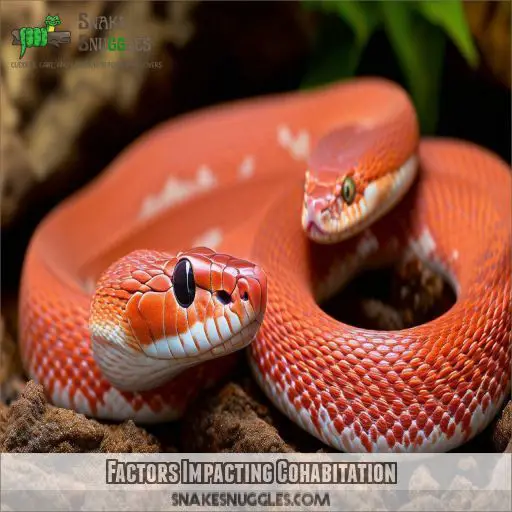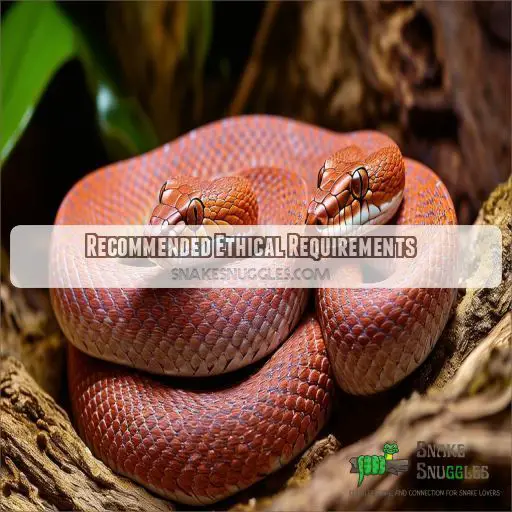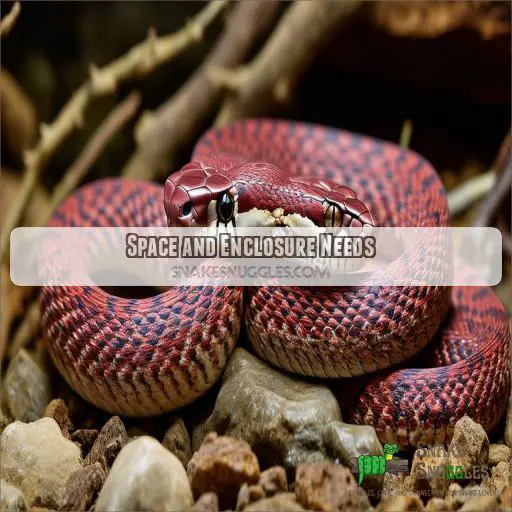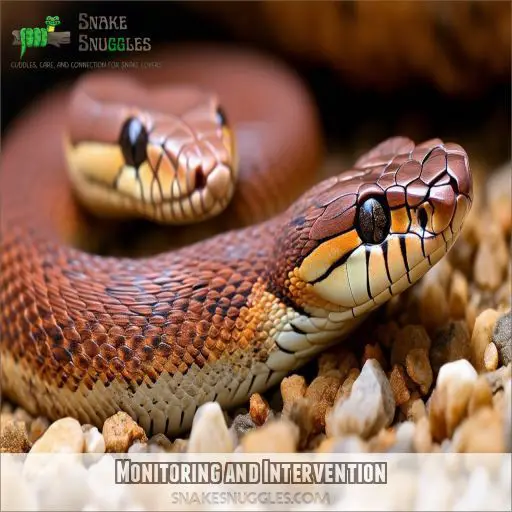This site is supported by our readers. We may earn a commission, at no cost to you, if you purchase through links.
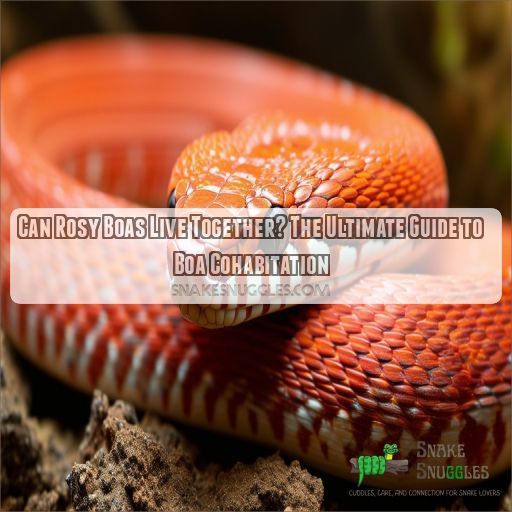 Curious about housing multiple rosy boas together? You’re not alone.
Curious about housing multiple rosy boas together? You’re not alone.
While these gentle snakes can coexist under certain conditions, it’s important to understand the things to consider involved.
Rosy boas require specific habitat conditions, including a thermal gradient with an 85-90°F basking area, 75-80°F cool end, and moderate humidity around 30%, which can be challenging to maintain in a shared rosy boa care environment. This guide will explore whether rosy boa snakes can live together in one cage, considering factors like behavior, space requirements, and potential risks.
We’ll provide you with the knowledge you need to make an informed decision about cohabitation, ensuring the safety and well-being of your pet snakes.
Table Of Contents
- Key Takeaways
- Can Rosy Boa Snakes Live Together in One Cage?
- Suitability of Cohabbing Rosy Boas
- Factors Impacting Cohabitation
- Recommended Ethical Requirements
- Space and Enclosure Needs
- Habitat Design for Cohabitation
- Key Considerations for Successful Cohabitation
- Monitoring and Intervention
- Frequently Asked Questions (FAQs)
- Can rosy boas be housed together?
- What size cage does a rosy boa need?
- Are rosy boas solitary?
- What size tank does a rosy sand boa need?
- How do rosy boas communicate with each other?
- Can different color morphs of rosy boas cohabitate?
- Do cohabiting rosy boas develop social hierarchies?
- How does cohabitation affect rosy boas feeding responses?
- Can related rosy boas (siblings) be safely housed together?
- Conclusion
Key Takeaways
- Cohabitation is a bit like a snake soap opera – possible, but drama may ensue! While rosy boas can live together under certain conditions, it’s not always smooth sailing. Keep your eyes peeled for any hissy fits or territorial tussles.
- Size matters, folks! When it comes to housing multiple rosy boas, think "the bigger, the better." A spacious vivarium is key to keeping the peace. Just remember, even with all that room, these slithery roommates might still get under each other’s scales.
- Playing matchmaker with rosy boas? Consider their individual personalities first. Some snakes are social butterflies, while others prefer the bachelor life. It’s like a reptilian dating game – make sure your snakes are compatible before moving in together!
- Monitoring is the name of the game. Keep a watchful eye on your scaly pals, looking for signs of stress or aggression. After all, you don’t want your vivarium turning into Snake Big Brother – evictions can get messy!
Can Rosy Boa Snakes Live Together in One Cage?
While rosy boa snakes can live together in one cage, it’s generally not recommended.
These snakes are solitary creatures by nature and don’t benefit from companionship.
Cohabitation can lead to stress, competition for resources, and even cannibalism in extreme cases.
If you’re thinking about housing multiple rosy boas, you’ll need a spacious enclosure with multiple hides, basking spots, and feeding areas.
Closely watching them is key to make sure each snake’s doing okay.
There’s a lot more to think about when it comes to the ethical and practical aspects of rosy boa cohabitation.
Suitability of Cohabbing Rosy Boas
Rosy boa cohabitation is a complex topic, and it’s important to think about the unique characteristics of these snakes.
Their temperament is a key factor, as individual variations can influence their compatibility with cohabitation. While rosy boas (Lichanura trivirgata) are generally docile and easy to handle, it’s crucial to consider their individual personalities.
Geographical variation is another essential aspect to consider. As rosy boas are native to the southwestern US and northwestern Mexico, their housing requirements, including temperature and humidity, should reflect their natural habitat.
Ethical considerations are also key when discussing rosy boa cohabitation, ensuring their well-being and safety.
Factors Impacting Cohabitation
When considering cohabitation, it’s important to understand the behavioral dynamics of rosy boas. While some snakes may get along just fine, others might exhibit territorial behavior or aggression, especially during breeding season.
Behavioral Considerations
Understanding Boa Social Dynamics
When it comes to rosy boa cohabitation, it’s important to understand their social dynamics and potential behavioral challenges. Here are some key factors to keep in mind:
- Rosy Boa Temperament: Rosy boas are generally docile and non-aggressive. However, individual temperaments can vary, and some boas may be more territorial or dominant than others. It’s important to observe your snakes’ behaviors and interactions carefully.
- Territorial Boa Behavior: Boas can exhibit territorial behavior, especially when it comes to defending their hiding spots or preferred basking areas. Providing multiple hides and ample space can help mitigate potential conflicts.
- Dominance Hierarchy: In a cohabitation setup, a dominance hierarchy may establish itself. This can lead to one boa becoming more dominant and claiming resources, which could impact the health and well-being of the subordinate boa.
- Boa Communication: Snakes primarily communicate through body language and pheromones. Understanding their subtle cues, such as tail positioning and tongue flicking, can help you interpret their moods and social interactions.
Breeding Implications
If you’re thinking about breeding rosy boas, cohabitation can boost your chances of success.
But it also brings some risks and ethical questions.
Keeping them together means they’re more likely to breed naturally, which is great if that’s your goal.
But remember, breeding snakes has specific needs and challenges.
You’ll need to separate them at the right time to avoid cannibalism or the risk of the female getting eaten.
Plus, there are ethical things to think about, like making sure the snakes stay healthy and live long lives, and being responsible with any babies they might have.
Recommended Ethical Requirements
When thinking about keeping two rosy boas together, it’s important to make sure their well-being comes first. Here are three key things to think about:
- Space Needs: Make sure the tank has enough room for two rosy boas to move around, hide, and have their own space. This can help prevent fights and gives them a fun place to live.
- Monitor Behavior: Watch your snakes closely and see how they’re acting. Look for any signs of aggression, stress, or wanting to be alone. Catching problems early can help prevent bigger issues.
- Individual Needs: Remember that each snake is different and has its own needs. This includes what they eat, how warm they like it, and where they like to hide. Make sure you can meet these needs even when they share a space.
Space and Enclosure Needs
Space and enclosure size are really important when you’re keeping rosy boas together. While a bigger vivarium has some perks, like giving them more room to explore and better temperature differences, it’s also important to make sure it doesn’t make them feel less secure.
The enclosure size should be based on how big your rosy boas will get as adults. A good rule of thumb is to give them at least as much space as their length multiplied by half their length, then multiplied by half again. For example, an adult rosy boa that’s 44 inches long would need a minimum enclosure that’s 44 inches long by 11 inches wide by 11 inches tall.
But it’s always better to give them a bigger enclosure as long as it’s set up right. A 125-liter by 50-liter vivarium can give two rosy boas plenty of space to live together comfortably.
Habitat Design for Cohabitation
When designing a habitat for cohabitating rosy boas, it’s important to focus on substrate and hides, as well as temperature and lighting. These factors really matter in keeping your snakes happy and healthy.
Substrate and Hides
When cohabiting rosy boas, your substrate and hide choices are really important. Opt for a deep, sandy substrate that allows for natural burrowing behaviors. Provide multiple hides to reduce competition and stress. Remember:
- Use 3-4 inches of sand or sandy soil substrate
- Place hides on both warm and cool sides
- Incorporate decor like rocks and branches for enrichment
Choose options that mimic their natural habitat, ensuring safety and comfort for your scaly roommates.
Temperature and Lighting
Now that you’ve got the substrate and hides sorted, let’s tackle temperature and lighting.
You’ll need to create a thermal gradient in your larger enclosure.
Use a heat mat on one side and install a UVB bulb for essential vitamin D3 synthesis.
Aim for a basking area of 90-95°F, with a cooler side around 75-80°F.
This setup helps your rosy boas regulate their body temperature, just like in their natural habitat.
Key Considerations for Successful Cohabitation
When considering rosy boa cohabitation, you’ll need to weigh the pros and cons carefully, making sure your vivarium setup can accommodate multiple snakes. It’s really important to assess your snakes’ individual temperaments, as this will greatly impact their ability to live together harmoniously.
Pros & Cons
Sharing a tank with another rosy boa? It’s a big decision! There are some good things, like maybe they’ll have babies and a more interesting place to live. But there’s also some bad stuff, like fights and problems with feeding. The most important thing is keeping your snakes healthy and safe. Here are some things to think about:
- More space to move around and act natural
- Babies might happen, or they could get in a fight over territory
- It’s hard to keep track of how each snake is doing and if they’re eating alright
Vivarium Setup
When setting up a vivarium for rosy boa cohabitation, you’ll need to think about a few things. Here’s a quick guide to help you create the perfect home for your snakes:
| Element | Requirement | Importance |
|---|---|---|
| Size | 125L x 50W | High |
| Heating | Reptirad | Critical |
| UV | Powerful source | Essential |
| Hides | Multiple | Key |
| Substrate | Sand/soil mix | Important |
Snake Temperament
When considering cohabitation for rosy boas, understanding their temperament is really important. These snakes are generally:
- Shy and docile, preferring to hide
- Occasionally bold, especially during feeding
- Timid when approached by larger creatures
- Curious about their environment
- Solitary by nature
Despite myths about snakes being aggressive, rosy boas are typically calm. However, individual personalities can vary. You’ll need to observe your snakes closely to determine if they’re compatible for cohabitation, as temperament plays a big role in success.
Monitoring and Intervention
When cohabiting rosy boas, you’ll need to keep a watchful eye on their behavior.
Look out for signs of aggression, such as hissing, striking, or one snake consistently dominating the other.
Stress indicators can include reduced appetite, excessive hiding, or unusual restlessness.
If you spot these issues, it’s important to take action right away.
Separate feeding times can help prevent food-related conflicts, but be prepared to house them individually if problems persist.
Regular health checks are essential; watch for changes in weight, shedding patterns, or activity levels.
Your snake care manual should include a section on monitoring and problem-solving.
By staying vigilant and addressing concerns early, you’ll help your rosy boas thrive together.
After all, successful cohabitation is a delicate balance of nature and nurture.
Frequently Asked Questions (FAQs)
Can rosy boas be housed together?
You shouldn’t house rosy boas together. They’re solitary creatures and can become aggressive or stressed when sharing space. It’s best to give each snake its own enclosure to keep them healthy and happy.
What size cage does a rosy boa need?
You’ll need a 20-gallon enclosure for an adult rosy boa. It’s really important to provide enough space for your snake to move, thermoregulate, and hide. Remember, the bigger the better for your pet’s home.
Are rosy boas solitary?
Aren’t rosy boas fascinating creatures? You’ll find they’re generally solitary. These snakes prefer their own space and don’t need companionship. It’s best to house them individually to avoid stress and potential conflicts. They’re happiest when they’re flying solo.
What size tank does a rosy sand boa need?
You’ll need a 20-30 gallon tank for an adult rosy sand boa. It should be at least as long as your snake and half as wide. Remember, bigger is better for your scaly friend’s exploration and comfort.
How do rosy boas communicate with each other?
Silent and subtle, rosy boas communicate through body language and pheromones. You’ll notice they flick their tongues to sense their environment, use scent trails for mating, and may engage in gentle touching during courtship or territorial displays.
Can different color morphs of rosy boas cohabitate?
Different color morphs of rosy boas can cohabitate, but it’s not recommended. You’ll risk potential aggression, breeding complications, and stress. It’s best to house them separately to keep them healthy and avoid any unforeseen issues.
Do cohabiting rosy boas develop social hierarchies?
You’ll find that rosy boas don’t typically develop complex social hierarchies. They’re solitary by nature, so when cohabiting, they’ll generally tolerate each other’s presence rather than establish a structured social order. It’s best to monitor their interactions closely.
How does cohabitation affect rosy boas feeding responses?
Like a lion’s pride, cohabiting rosy boas can complicate feeding. You’ll notice heightened competition and potential aggression during meals. Their individual appetites may fluctuate, and some snakes might become food-aggressive. It’s important to watch and adjust feeding practices accordingly.
Can related rosy boas (siblings) be safely housed together?
You shouldn’t house sibling rosy boas together. While they’re related, they can still exhibit territorial behavior and aggression. It’s safer to keep them in separate enclosures to prevent stress, potential fighting, and make sure they eat properly.
Conclusion
Picture two rosy boas coiled peacefully in a spacious vivarium.
While it’s possible for rosy boa snakes to live together in one cage, it’s not always advisable.
You’ve learned the key things to think about, from behavior to space requirements.
Weigh the pros and cons carefully before deciding.
Ultimately, your rosy boas’ health and well-being should guide your choice.
With proper care, you can create a thriving environment for your serpentine companions.


